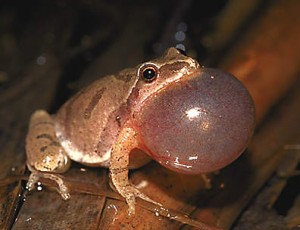Any animal that relies heavily on vocal communication must adjust this behavior in the face of conflicting environmental sounds, such as wind, rain, cars, or even songs of other species. Like other animals, birds heavily rely on this communication mode for a number of important processes such as attracting mates and defending precious territory. Since these processes are critical, any conflicting sounds that may impede the message are a major problem. Birds get around this by adjusting their song; and just to make sure, the type of adjustment varies according to the type of sound at hand. This can result in changing either the timing of singing or the frequency pitch of the song.
The White-throated sparrow exemplifies this problem solving as it tweaks its singing behavior to compensate for masking sounds in its environment, specifically that of the Spring peeper frog (Lenske & La, 2014). While there is already evidence that the sparrow adjusts its song towards urban noise, the nature of adjustment towards is habitat-mate peeper frog has gone unknown until now. Their shared habitat and similar song characteristics can be a source of acoustic tension, but the sparrow overcomes this obstacle with its flexible frequency defense.
Both species’ songs are similar in time characteristics and frequency features. The small sparrow sings a series of whistles at a high pitched frequency, while the peeper repetitively peeps with a similar high pitched frequency (Lenske & La, 2014). Additionally, both species call from early evening to dawn, which can throw a wrench into the sparrow’s critical mate-attraction and territory-protecting vocal tasks. But, rather than endure defeat by this competitive noise–which is out of the question for its fierce reproductive goals– the sparrow instead sings at a higher frequency when the spring peeper “choruses” in their shared home.
When two sounds have similar frequencies, their identical wavelengths collide and “mask”, or cancel out, each other. By increasing its singing frequency, the sparrow prevents this clashing and effectively raises its song above the noise to reach its target fellow sparrows.
White-throated sparrows do not always use the frequency defense. Instead, they tailor their response relative to the characteristics of the conflicting sound at hand. When faced with loud winds, the sparrow sings longer songs, likely as a mode to combat the frequent, quick changes in acoustic intensity that a wind sound produces (Lenske & La, 2014). Conversely, during other bird species song or car noises, the sparrow momentarily ceases its singing (Lenske & La, 2014). Either way, the sparrow shows that any obstacle in the environment can be overcome with a little adjustment.
Lenske, Ariel K., and Van T. La. “White-throated Sparrows Alter Songs Differentially in Response to Chorusing Anurans and Other Background Noise.” Behavioural Processes 105 (2014): 28-35.


